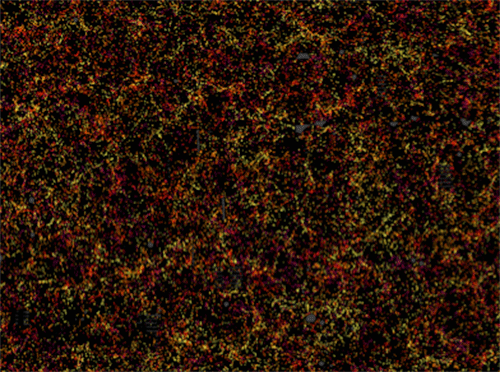Research News: Editors’ Choice
Big Data for Astronomers
After a decade’s work, researchers with the Sloan Digital Sky Survey have released the most comprehensive galaxy map to date, containing 1.2 million galaxies in a volume of 650 billion cubic light years. The map has allowed the group to make the most precise calculation of the effect of dark energy on the expansion of the Universe. Even though about 70% of all of the energy in the observable Universe is believed to be dark energy, little is known about it. The latest measurements were made as part of the Baryon Oscillation Spectroscopic Survey (BOSS) and the results are contained in a group of papers posted to arXiv.org. BOSS looks for oscillations in the distribution of visible matter that were frozen into place following the big bang. This information can be used to determine the expansion rate of the Universe, which allows researchers to understand the balance between dark energy accelerating the expansion and matter gravitationally slowing it. The hope now is that a detailed comparison of the BOSS results with precision maps of the cosmic microwave background (e.g., from the Planck mission) will drive improvements in the standard cosmological model of the Universe.
A Room-Temperature Supercurrent
Researchers found that a supercurrent can flow at room temperature in a Bose-Einstein condensate of quasiparticles called magnons. Supercurrents are known to occur in superconductors (in the form of resistance-free charge currents) and superfluids (which support viscosity-free particle currents). Both of these systems are Bose-Einstein condensates (BECs) that can be described by a single wave function. But since heat destroys a BEC, such supercurrents have only been observed at cryogenic temperatures. As described in Nature Physics, the new experiments of Bozhko et al. indicate a room-temperature supercurrent of magnons flowing in a ferrimagnetic film. The result builds on previous work by some of the same authors, which demonstrated that magnons can form a BEC at room temperature. In the new study, the researchers used a laser to create a temperature gradient that drives a magnon current in the ferrimagnetic film hosting the magnon BEC. According to the authors, the resulting magnon density, which they measured with light-scattering experiments, can only be explained by the presence of a supercurrent. If further experiments confirm the dissipationless nature of these currents, the scheme could lead to low-power-consumption logic and memory magnonic devices.
Those Eyes, Those Cephalopod Eyes
A pair of researchers has proposed a way that cephalopods—octopi, squids, and cuttlefish—can have color vision while technically being color blind. Organisms like humans see color because of multiple types of visual photoreceptors that produce different neural signals depending on wavelength. But marine animals like the cuttlefish have only one type of photoreceptor, yet they change their coloration to communicate with others of their species. In the Proceedings of the National Academy of Sciences, Stubbs and Stubbs suggest that cephalopods employ chromatic aberration and an off-axis pupil structure to achieve color sensing, although they are color blind in terms of photoreceptors. Chromatic aberration in a lens occurs when different wavelengths of light have different focal lengths. Considered a nuisance in telescopes, it could, however, confer color vision on cephalopods if varying the distance between lens and retina enabled the animal to acquire images in different colors. To test the idea, the researchers created a numerical model of such a visual system and found the results agree well with existing visual and physiological data on marine animals. They conclude by suggesting that other species with limited photoreceptor variety, such as spiders and some marine mammals, may have the same ability to overcome apparent color blindness.
IceCube Searches for Sterile Neutrinos
A search for sterile neutrinos with IceCube—the world’s largest neutrino detector—has found no evidence for the hypothetical particles, significantly narrowing the range of masses that a new kind of neutrino could possibly have. Following hints seen in some experiments, sterile neutrinos were proposed to interact with matter only through gravity, and researchers have sought such particles for decades. Some of these searches attempted to find evidence of sterile neutrinos from the oscillation of the known neutrinos. Normally, an oscillation caused by sterile neutrinos should be small. But if it occurs as the neutrinos pass through dense matter, it may be greatly enhanced by a so-called matter-induced resonance effect, creating a sizable disappearance of the muon neutrinos at certain energies. As reported in Physical Review Letters, IceCube looked for this disappearance for neutrinos and antineutrinos with energies between 320 GeV and 20 TeV, a range in which the resonance effect had never been explored. However, no such disappearance was observed. Whether other experiments may soon more completely rule out the possibility of sterile neutrinos or might close in on a crucial discovery is still to be determined. (For more, see the Viewpoint “Hunting the Sterile Neutrino” by David Schmitz.)
Visualizing a Heartbeat
Researchers have engineered a new kind of artificial tissue in which cells’ electrical activity can be stimulated and visualized with light. To achieve such a feat, McNamara et al. incorporated four additional gene sequences into human embryonic kidney cells. Two produced ordinary ion channels; the other two produced blue-light-activated ion channels (i.e., light-sensitive switches) and a protein that fluoresces with an intensity that depends on the voltage across the membrane in which it is embedded. Light activation of electrically excitable cells has been shown before, but the team has now included a convenient readout mechanism (the fluorescent protein). By means of patterning methods they can shape the cell cultures into “tissue circuits.” They grew rings of cells a few millimeters in diameter that could support circulating waves of electrical excitation. The coordination of this excitation is reminiscent of rhythmic activity in cardiac tissue. The researchers, who report their findings in Physical Review X, say that these tissues could be used to understand real cardiac cells, especially when exhibiting behavior such as arrhythmias. (For more, see the Focus article “Biological Cells Form Electric Circuits.”)
How to Roast Coffee by Ear
Coffee geeks rejoice: thanks to physics, an innovation in roasting may be just around the corner. Mechanical engineer Preston Wilson analyzed the sounds from roasting coffee to learn whether they could control an automatic roaster. Experienced roasters tweak a coffee’s flavor by listening for the “first crack,” a small popcorn-like explosion caused by steam escaping from the hot beans. Cutting off the heat soon after gives a light roast with high acidity, while waiting longer lets the sugars caramelize and (slightly) reduces the caffeine content. Eventually a “second crack” like a distant firecracker comes from the breakdown of cellulose in the beans and the release of oils, signaling a darker roast. To find out if these sounds were different enough, Wilson recorded a performance by an espresso blend in a home-roaster, capturing 62 first-crack events and 241 second-crack events. As he reports in the Journal of the Acoustical Society of America, first crack is louder (by 15%) and occurs at a lower frequency (factor of 19) and rate (factor of 5) than second crack, suggesting a robo-roaster could differentiate the two.







